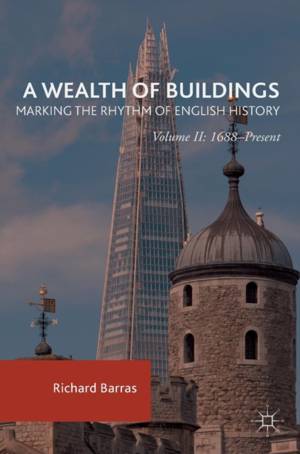
- Afhalen na 1 uur in een winkel met voorraad
- Gratis thuislevering in België vanaf € 30
- Ruim aanbod met 7 miljoen producten
- Afhalen na 1 uur in een winkel met voorraad
- Gratis thuislevering in België vanaf € 30
- Ruim aanbod met 7 miljoen producten
Zoeken
A Wealth of Buildings: Marking the Rhythm of English History
Volume II: 1688-Present
Richard Barras
Hardcover | Engels
€ 167,95
+ 335 punten
Uitvoering
Omschrijving
This two-volume book explores how the great buildings of England bear witness to a thousand years of the nation's history. In every age, investment in iconic buildings reaches a climax when the prevailing mode of production is operating most effectively, surplus wealth is most plentiful, and the dominant class rules supreme. During such periods of stability and prosperity, the demand for new buildings is strong, structural and stylistic innovations abound, and there is fierce competition to build for lasting fame. Each such climax produces a unique vintage of hegemonic buildings that are monuments to the wealth and power of those who ruled their world. This second volume presents three case studies of iconic building investment from the eighteenth century to the present day. During the eighteenth century the wealth of the great landed estates funded the golden age of country house building by aristocracy and gentry. During the nineteenth century the Industrial Revolution unleashed an unprecedented wave of infrastructure investment and civic building by the ascendant capitalist class. Since the late twentieth century the power of global financial capital has been symbolized by the relentless rise of city centre office towers. A final chapter argues that these different forms of hegemonic building are a physical manifestation of the underlying rhythm of English history.
Specificaties
Betrokkenen
- Auteur(s):
- Uitgeverij:
Inhoud
- Aantal bladzijden:
- 431
- Taal:
- Engels
Eigenschappen
- Productcode (EAN):
- 9781349949793
- Verschijningsdatum:
- 5/10/2016
- Uitvoering:
- Hardcover
- Formaat:
- Genaaid
- Afmetingen:
- 153 mm x 216 mm
- Gewicht:
- 657 g

Alleen bij Standaard Boekhandel
+ 335 punten op je klantenkaart van Standaard Boekhandel
Beoordelingen
We publiceren alleen reviews die voldoen aan de voorwaarden voor reviews. Bekijk onze voorwaarden voor reviews.











